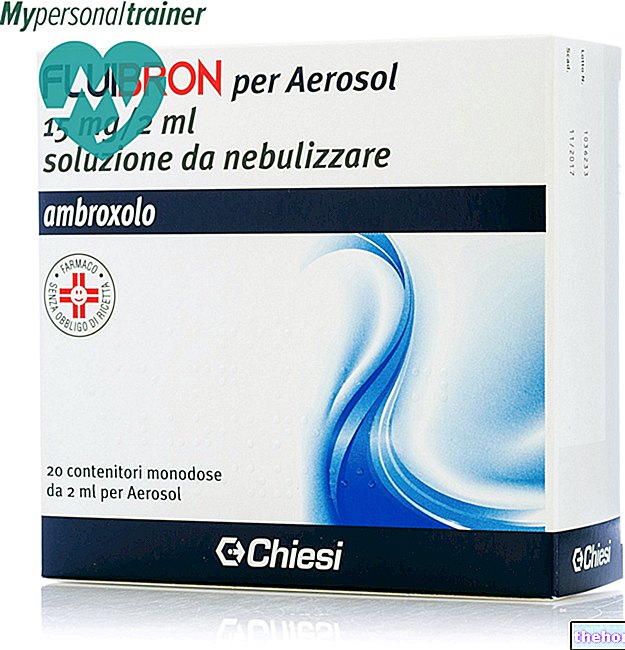Active ingredients: Pantoprazole
MAALOX REFLUX 20 mg gastro-resistant tablets
Why is Maalox Reflux used? What is it for?
MAALOX REFLUX contains the active substance pantoprazole, which blocks the 'pump' that produces stomach acid. So it reduces the amount of acid in your stomach.
MAALOX REFLUSSO is used for the short-term treatment of reflux symptoms (eg heartburn, acid regurgitation) in adults.
Reflux is the return of acid from the stomach into the esophagus ("food canal"), which can become inflamed and painful. This can cause symptoms such as a painful burning sensation in the chest that rises to the throat (heartburn) and a sour taste in the mouth (acid regurgitation).
You may experience relief of your acid reflux and heartburn symptoms just after one day of treatment with MAALOX REFLUX, but this drug is not designed to bring immediate relief. It may be necessary to take the tablets for 2-3 consecutive days to improve symptoms.
Contraindications When Maalox Reflux should not be used
Do not take MAALOX REFLUX
- if you are allergic to pantoprazole, soya lecithin or any of the other ingredients of this medicine (listed in section 6).
- if you are taking a medicine containing atazanavir (to treat HIV infection)
- See "Other medicines and MAALOX REFLUX"
Precautions for use What you need to know before taking Maalox Reflux
Talk to your doctor or pharmacist before taking MAALOX REFLUX
- If you have liver problems or jaundice (yellowing of the skin or eyes).
- If you have been treated for heartburn or indigestion continuously for 4 or more weeks.
- If you are over 55 and take non-prescription indigestion treatments daily.
- If you are over 55 and have new or recently changed reflux symptoms.
- If you have previously had a stomach ulcer or stomach surgery.
- If you go to your doctor regularly for serious health conditions or ailments.
- If you need to have an endoscopy or a breath test called a C-urea test.
Tell your doctor immediately, before or after taking this drug, if you notice any of the following symptoms, which could be a sign of another, more serious, disorder:
- Unintentional weight loss (not related to a diet or exercise program).
- Vomiting, particularly if recurrent.
- Presence of blood in the vomit; in vomit this may appear dark in color like coffee grounds.
- Presence of blood in the stool, which may appear black or tar-like.
- Difficulty in swallowing or pain when swallowing.
- He looks pale and feels weak (anemia).
- Chest pain.
- Stomach ache.
- Severe and / or persistent diarrhea, because MAALOX REFLUX has been associated with a slight increase in infectious diarrhea.
Your doctor may decide that you need some tests. If you have a blood test, tell your doctor that you are taking this medicine.
You may have relief from acid reflux and heartburn symptoms after only one day of treatment with MAALOX REFLUX, but this drug is not designed to bring immediate relief. You must not take it as a preventative measure.
If you have suffered from recurrent heartburn or indigestion symptoms for some time, remember to go to the doctor regularly.
Children and adolescents
MAALOX REFLUSSO should not be used by children and adolescents under 18 years of age due to a lack of safety data in this younger age group.
Interactions Which drugs or foods can modify the effect of Maalox Reflux
Tell your doctor or pharmacist if you are taking, have recently taken or might take any other medicines. MAALOX REFLUSSO can affect the effectiveness of other medicines. Tell your doctor or pharmacist if you are taking medicines containing any of the following active ingredients:
- atazanavir (used to treat "HIV infection). You should not use MAALOX REFLUX if you are taking atazanavir. See" Do not take MAALOX REFLUX ".
- Ketoconazole (used for fungal infections).
- Warfarin and phenprocoumon (used to thin the blood and prevent clots). You may need further blood tests.
- Methotrexate (used to treat rheumatoid arthritis, psoriasis and cancer) - if you are taking methotrexate your doctor may temporarily stop taking MAALOX REFLUX because pantoprazole can increase the levels of methotrexate in the blood.
Do not take MAALOX REFLUX with other medicines that limit the amount of acid produced in the stomach, such as another proton pump inhibitor (omeprazole, lansoprazole or rabeprazole) or an H2 antagonist (e.g. ranitidine, famotidine). However, if necessary, you can take MAALOX REFLUX with antacids (e.g. magaldrate, alginic acid, sodium bicarbonate, aluminum hydroxide, magnesium carbonate, or combinations thereof).
Warnings It is important to know that:
Pregnancy and breastfeeding
You should not take this drug if you are pregnant or breastfeeding. If you are pregnant or breast-feeding, think you may be pregnant or are planning to have a baby, ask your doctor or pharmacist for advice before taking this medicine.
Driving and using machines
If you notice any side effects such as dizziness or disturbed vision, you should not drive or operate machinery.
MAALOX REFLUSSO contains maltitol and lecithin
If you have been told by your doctor that you are intolerant to some sugars, contact your doctor before taking this medicine. MAALOX REFLUSSO contains soy lecithin. If you are allergic to peanuts or soy, do not use this medicine.
Dose, Method and Time of Administration How to use Maalox Reflux: Posology
Always take this medicine exactly as described in this leaflet and / or as directed by your doctor or pharmacist. If in doubt, consult your doctor or pharmacist.
Take one tablet a day. Do not exceed this recommended dose of 20 mg of pantoprazole per day.
You must take this drug for at least 2-3 consecutive days. Stop taking MAALOX REFLUX when you no longer have any symptoms. You may experience relief from your acid reflux and heartburn symptoms just after one day of treatment with MAALOX REFLUX, but this drug is not designed to bring immediate relief.
If you have no symptom relief after taking this drug for 2 weeks continuously, consult your doctor. Do not take MAALOX REFLUX for more than 4 weeks without consulting your doctor.
Take the tablet before a meal, at the same time each day. You should swallow the tablet whole with some water. Do not chew or break the tablet.
Overdose What to do if you have taken too much Maalox Reflux
If you take more MAALOX REFLUX than you should
Consult your doctor or pharmacist if you have taken more than the recommended dose. If possible, take your medicine and this leaflet with you.
If you forget to take MAALOX REFLUX
Do not take a double dose to make up for a forgotten dose. Take your next normal dose, the next day, at the appointed time. If you have any further questions on the use of MAALOX REFLUX, ask your doctor or pharmacist.
Side Effects What are the side effects of Maalox Reflux
Like all medicines, this medicine can cause side effects, although not everybody gets them.
If you experience any of the following serious side effects, see your doctor immediately or contact your nearest hospital emergency department. Stop taking this medicine immediately, but take this leaflet and / or the tablets with you.
- Severe allergic reactions (frequency rare: may affect up to 1 in 1,000 people): hypersensitivity reactions, so-called anaphylactic reactions, anaphylactic shock and angioedema. Typical symptoms are: swelling of the face, lips, mouth, tongue and / or throat, which can cause difficulty in swallowing or breathing, hives, severe dizziness with a very fast heartbeat and heavy sweating.
- Serious skin reactions (frequency not known: frequency cannot be estimated from the available data): rash with swelling, blistering or peeling of the skin, peeling and bleeding around the eyes, nose, mouth or genitals and rapid deterioration general health conditions, or skin rash when exposed to the sun.
- Other serious side effects (frequency not known: frequency cannot be estimated from the available data): yellowing of the skin and eyes (due to severe liver damage), or kidney problems such as pain in urinating and lower back pain with fever.
During the treatment with the active substance of the product MAALOX REFLUSSO the following undesirable effects have been observed:
- Uncommon (may affect up to 1 in 100 people) headache; dizziness diarrhea; feeling sick, vomiting; bloating and flatulence (meteorism); constipation; dry mouth; stomach ache and annoyance; skin rash or hives; itching; feeling weak, tired or generally unwell; sleep disorders; increase in liver enzymes in blood tests.
- Rare (may affect up to 1 in 1,000 people) alteration or complete lack of sense of taste; vision disturbances such as clouding; joint pain; muscle aches; weight changes; increase in body temperature; swelling of the extremities; depression; increased levels of bilirubin and fat in the blood (seen in blood tests), breast enlargement in men; high fever and sharp decrease in circulating granulocytes (seen in blood tests).
- Very rare (may affect up to 1 in 10,000 people) disorientation; reduction in the number of platelets in the blood, which can cause you to bleed or bruise more frequently than normal; reduction in the number of white blood cells, which can lead to more frequent infections; simultaneous abnormal reduction in the number of red and white blood cells, as well as platelets (seen in blood tests).
- Frequency not known (frequency cannot be estimated from the available data) hallucinations, confusion (especially in patients with a history of these symptoms); decrease in sodium levels in the blood, decrease in the level of magnesium in the blood.
Reporting of side effects
If you get any side effects, talk to your doctor or pharmacist. This includes any possible side effects not listed in this leaflet. You can also report side effects directly via the national reporting system at http://www.agenziafarmaco.gov.it/it/responsabili. By reporting side effects you can help provide more information on the safety of this medicine.
Expiry and Retention
Keep this medicine out of the sight and reach of children.
Do not use this medicine after the expiry date which is stated on the blister or bottle and carton. The expiry date refers to the last day of that month.
For tablets packed in plastic bottles: MAALOX REFLUSSO must be used within three months of first opening the container.
This medicinal product does not require any special storage conditions.
Do not throw any medicines via wastewater or household waste. Ask your pharmacist how to throw away medicines you no longer use. This will help protect the environment.
Contents of the pack and other information> Contents of the pack and other information
What MAALOX REFLUX contains
- The active ingredient is pantoprazole. Each tablet contains 20 mg of pantoprazole (as sodium sesquihydrate).
- The excipients are:
Nucleus:
maltitol (E 965), crospovidone type B, sodium caramellose, anhydrous sodium carbonate, calcium stearate.
Coating:
Poly (vinyl alcohol), talc, titanium dioxide (E 171), macrogol 3350, soy lecithin, yellow iron oxide (E 172), anhydrous sodium carbonate, ethyl acrylate methacrylic acid copolymer (1: 1), sodium lauryl sulfate, polysorbate 80, triethyl citrate.
Description of the appearance of MAALOX REFLUX and contents of the pack
The gastro-resistant tablets are yellow and oval. MAALOX REFLUSSO is available in OPA / Alu / PVC-Aluminum blisters or in HDPE bottles. Packs containing 7 or 14 gastro-resistant tablets.
Not all pack sizes may be marketed.
Source Package Leaflet: AIFA (Italian Medicines Agency). Content published in January 2016. The information present may not be up-to-date.
To have access to the most up-to-date version, it is advisable to access the AIFA (Italian Medicines Agency) website. Disclaimer and useful information.
01.0 NAME OF THE MEDICINAL PRODUCT
MAALOX REFLUX 20 MG GASTRORESISTANT TABLETS
02.0 QUALITATIVE AND QUANTITATIVE COMPOSITION
Each gastro-resistant tablet contains 20 mg of pantoprazole (as sodium sesquihydrate).
Excipients with known effect: 38.425 mg maltitol and 0.345 mg lecithin (derived from soybean oil) (see section 4.4).
For the full list of excipients, see section 6.1.
03.0 PHARMACEUTICAL FORM
Gastro-resistant tablet.
Yellow, oval tablet.
04.0 CLINICAL INFORMATION
04.1 Therapeutic indications
Short-term treatment of reflux symptoms (e.g. heartburn, acid regurgitation) in adults.
04.2 Posology and method of administration
Dosage
The recommended dose is 20 mg of pantoprazole (one tablet) per day.
It may be necessary to take the tablets for 2-3 consecutive days to improve symptoms. Once complete healing of symptoms is achieved, treatment should be stopped.
Treatment should not exceed 4 weeks without consulting a doctor.
If no improvement in symptoms is noted within 2 weeks of continuous treatment, the patient should seek medical attention.
Special populations
No dose adjustment is necessary in elderly patients or in patients with renal or hepatic impairment.
Pediatric population
The use of MAALOX REFLUX it is not recommended in children and adolescents below 18 years due to insufficient data on safety and efficacy.
Method of administration
The gastro-resistant tablets of MAALOX REFLUX 20 mg should not be chewed or crushed, and should be swallowed whole with liquid before a meal.
04.3 Contraindications
Hypersensitivity to the active substance, substituted benzimidazoles, to lecithin (derived from soybean oil) or to any of the other excipients listed in section 6.1.
Concurrent administration with atazanavir (see section 4.5).
04.4 Special warnings and appropriate precautions for use
Patients should be instructed to contact their physician if:
• have unintended weight loss, anemia, gastrointestinal bleeding, dysphagia, recurrent vomiting or blood vomiting, since treatment with pantoprazole can relieve symptoms and delay the diagnosis of a serious disease. In these cases a malignant pathology must be excluded.
• have previously had gastric ulcer or gastrointestinal surgery.
• have been on continuous symptomatic treatment for indigestion or heartburn for 4 weeks or more.
• have jaundice, liver impairment, or liver disease.
• have any other serious illness that affects general well-being.
• are over 55 with new or recently changed symptoms.
Patients with recurring symptoms of indigestion or heartburn should see their doctor at regular intervals. In particular, patients over 55 who take any non-prescription medicine for indigestion or heartburn on a daily basis should inform their pharmacist or doctor.
Patients should not take another proton pump inhibitor or H2 antagonist at the same time.
Patients who need to undergo endoscopy or breath tests should consult their doctor before taking this medicine.
Patients should be advised that the tablets are not intended to provide immediate relief. Patients may begin to experience improvement in symptoms after approximately one day of treatment with pantoprazole, but it may be necessary to take it for 7 days to achieve complete control of heartburn.
Patients should not take pantoprazole as a preventative drug.
Gastrointestinal infections caused by bacteria
Reduction of gastric acidity for any reason, including proton pump inhibitors, increases the gastric count of bacteria normally present in the gastrointestinal tract. Treatment with acid-lowering drugs causes a slightly increased risk of gastrointestinal infections like Salmonella, Campylobacter or Clostridium difficile.
Soy lecithin
This medicine contains lecithin derived from soybean oil. If the patient is allergic to peanut or soya, he should not use this medicine.
Maltitol
This medicine contains maltitol.
Patients with rare hereditary problems of fructose intolerance should not take this medicine.
04.5 Interactions with other medicinal products and other forms of interaction
Effect of pantoprazole on the absorption of other medicinal products
MAALOX REFLUX it can reduce the absorption of active ingredients whose bioavailability depends on the gastric pH (eg ketoconazole).
HIV drugs (atazanavir)
Co-administration of atazanavir 300 mg / ritonavir 100 mg with omeprazole (40 mg once daily) or atazanavir 400 mg with lansoprazole (60 mg single dose) to healthy volunteers has been shown to result in a substantial reduction in the bioavailability of atazanavir.
Absorption of atazanavir is pH-dependent. Therefore, pantoprazole should not be administered concomitantly with atazanavir (see section 4.3).
Coumarin anticoagulants (phenprocoumon or warfarin)
Although no interactions were observed during concomitant treatment with phenprocoumon or warfarin in clinical pharmacokinetic studies, some isolated cases of International Normalized Ratio (INR) variation have been reported during concomitant treatment in the post-marketing period. Thus, in patients treated with coumarin anticoagulants (e.g. phenprocoumon or warfarin), it is recommended to monitor the prothrombin time / INR when starting treatment with pantoprazole, when it is discontinued or when administered intermittently.
Methotrexate
In some patients, concomitant use of high-dose methotrexate (eg 300 mg) and proton pump inhibitors has been reported to increase methotrexate levels. Therefore, in cases where methotrexate is used in high doses, to For example, in the treatment of cancer and psoriasis, a temporary suspension of therapy with pantoprazole should be considered.
Other interaction studies
Pantoprazole is metabolised in the liver by the cytochrome P450 enzyme system.
Interaction studies with carbamazepine, caffeine, diazepam, diclofenac, digoxin, ethanol, glibenclamide, metoprolol, naproxen, nifedipine, phenytoin, piroxicam, theophylline and an oral contraceptive containing levonorgestrel and ethinyl estradiol did not show clinically significant interactions.
In any case, an interaction of pantoprazole with other substances which are metabolised by the same enzyme system cannot be excluded.
There were no interactions with concomitantly administered antacids.
04.6 Pregnancy and lactation
Pregnancy
There are no adequate data on the use of pantoprazole in pregnant women. Studies in animals have shown reproductive toxicity. Preclinical studies have not shown impaired fertility or teratogenic effects (see section 5.3). The potential risk to humans. humans is not known. MAALOX REFLUX it doesn't have to be during pregnancy.
Breastfeeding
It is not known whether pantoprazole is excreted in human milk. Animal studies have shown excretion of pantoprazole in breast milk. This medicine should not be used during breastfeeding.
Fertility
There was no evidence of impaired fertility following administration of pantoprazole in animal studies (see section 5.3).
04.7 Effects on ability to drive and use machines
Adverse drug reactions such as dizziness and visual disturbances may occur (see section 4.8). In such cases, patients should not drive or operate machinery.
04.8 Undesirable effects
Approximately 5% of patients can be expected to experience adverse drug reactions (ADRs). The most commonly reported adverse reactions are diarrhea and headache, both occurring in approximately 1% of patients.
The table below lists adverse reactions reported with pantoprazole, ranked under the following frequency classification: very common (≥1 / 10); common (≥1 / 100,
Within each frequency class, adverse reactions are reported in order of decreasing severity.
Table 1. Adverse reactions with pantoprazole in clinical studies and post-marketing experience
Reporting of suspected adverse reactions
Reporting of suspected adverse reactions occurring after authorization of the medicinal product is important as it allows continuous monitoring of the benefit / risk balance of the medicinal product. Healthcare professionals are asked to report any suspected adverse reactions via the national reporting system. "address https://www.aifa.gov.it/content/segnalazioni-reazioni-avverse.
04.9 Overdose
There are no known symptoms of overdose in humans.
Doses up to 240 mg administered intravenously over 2 minutes were well tolerated.
Since pantoprazole is extensively protein bound, it is not readily dialyzable.
In the event of an overdose with clinical signs of intoxication, other than symptomatic and supportive treatment, no specific therapeutic recommendations can be made.
05.0 PHARMACOLOGICAL PROPERTIES
05.1 Pharmacodynamic properties
Pharmacotherapeutic group: proton pump inhibitors.
ATC code: A02BC02.
Mechanism of action
Pantoprazole is a benzimidazole derivative which inhibits the secretion of hydrochloric acid in the stomach by specific blockade of the proton pumps of the parietal cells.
Pantoprazole is converted into its active form, a cyclic sulfenamide, in the acidic environment in the parietal cells where it inhibits the enzyme H +, K + -ATPase, ie the final stage in the production of hydrochloric acid in the stomach.
Inhibition is dose-dependent and affects both basal and stimulated acid secretion.
In most patients, heartburn and acid reflux symptoms resolve within 1 week.
Pantoprazole reduces acidity in the stomach and consequently increases gastrin in proportion to the reduction in acidity. The increase in gastrin is reversible. Since pantoprazole binds to the enzyme distal to the receptor level, it can inhibit the secretion of hydrochloric acid regardless of stimulation by other substances (acetylcholine, histamine, gastrin). The effect is the same whether the active ingredient is administered orally or intravenously.
Fasting gastrin values increase during treatment with pantoprazole. In short-term treatments, in most cases they do not exceed the upper limits of the norm. During long-term treatments, gastrin levels double in most cases. An excessive increase, however, only occurs in isolated cases. As a result, a mild to moderate increase in the number of specific endocrine cells (ECLs) in the stomach is observed in a minority of cases during long-term treatment (simple to adenomatoid hyperplasia). However, based on the studies performed to date, the formation of carcinoid precursors (atypical hyperplasia) or stomach carcinoids as found in animal experiments (see section 5.3) has not been detected in humans.
Clinical efficacy
In a retrospective analysis of 17 studies in 5960 patients with gastroesophageal reflux disease (GERD) treated with 20 mg pantoprazole monotherapy, symptoms associated with acid reflux such as heartburn and acid regurgitation were evaluated according to a standardized methodology.
Selected studies were required to have at least one acid reflux symptom at 2 weeks. The diagnosis of GERD in these studies was based on an endoscopic evaluation, with the exception of one study in which patient inclusion was based solely on symptomatology.
In these studies, the percentage of patients with complete recovery from heartburn after 7 days ranged from 54.0% to 80.6% in the pantoprazole group. After 14 and 28 days, complete recovery from heartburn was noted, respectively. in 62.9% -88.6% and in 68.1% -92.3% of patients.
As for complete recovery from acid regurgitation, results similar to those for heartburn were obtained. After 7 days the percentage of patients with complete recovery from acid regurgitation ranged from 61.5% to 84.4%, after 14 days from 67.7% to 90.4%, and after 28 days from 75.2% to 94.5%, respectively.
Pantoprazole was consistently superior to placebo and H2 antagonists and not inferior to other proton pump inhibitors (PPIs). The rates of improvement in acid reflux symptoms were largely independent of the initial state of GERD.
05.2 Pharmacokinetic properties
Pharmacokinetics do not vary after single or repeated administration. In the dose range of 10 to 80 mg, the plasma kinetics of pantoprazole are linear after both oral and intravenous administration.
Absorption
After oral administration, pantoprazole is completely and rapidly absorbed. The absolute bioavailability of the tablets was shown to be approximately 77%. On average, approximately 2.0 h - 2.5 h post administration (tmax) of a single oral dose of 20 mg, the maximum serum concentration (Cmax) of approximately 1-1.5 mcg / ml is reached, and these values remain constant after repeated administration. Concomitant food intake has no influence on bioavailability (AUC or Cmax), but increases the variability of lag-time (tlag).
Distribution
The volume of distribution is approximately 0.15 L / kg and the serum protein binding is approximately 98%.
Biotransformation
Pantoprazole is almost exclusively metabolised in the liver.
Elimination
Clearance is about 0.1 l / h / kg, and the terminal phase half-life (t½) is about 1 h. There have been few cases of subjects with slowed elimination. Due to the specific binding of pantoprazole to proton pumps within the parietal cells, the elimination half-life does not correlate with the longer duration of action (inhibition of acid secretion).
Renal elimination represents the major route of excretion (approximately 80%) for the metabolites of pantoprazole; the remainder is excreted in the faeces. The major metabolite in both serum and urine is desmethylpantoprazole, which is conjugated with sulphate. L "half-life of the main metabolite (approximately 1.5 h) is not much longer than that of pantoprazole.
Special populations
Kidney failure
Dose reduction is not recommended in cases where pantoprazole is administered to patients with impaired renal function (including patients on dialysis, which removes only negligible amounts of pantoprazole). As observed in healthy subjects, the half-life of pantoprazole is short. Although the major metabolite has a longer half-life (2-3h), excretion is nevertheless rapid and therefore no accumulation occurs.
Hepatic insufficiency
After administration of pantoprazole to patients with hepatic impairment (Child-Pugh class A, B and C) the half-life values increased from 3 to 7 h and the AUC values increased by a factor of 3-6, while Cmax was increased only slightly by a factor of 1.3 compared to that of healthy subjects.
Senior citizens
The slight increase in AUC and Cmax values in elderly volunteers compared to younger subjects is not clinically relevant.
05.3 Preclinical safety data
Non-clinical data reveal no special hazard for humans based on conventional studies of safety pharmacology, repeated dose toxicity and genotoxicity.
In the 2-year carcinogenicity study in rats, neuroendocrine neoplasms were found. Also, squamous cell papillomas were found in the front of the stomach of rats in one study. The mechanism leading to the formation of stomach carcinoids by the substituted benzimidazoles has been thoroughly investigated and has led to the conclusion that it is a secondary reaction to the massive increase in serum gastrin levels that occurs in the rat during chronic high-temperature treatment. doses.
In the 2-year rodent studies, an increased number of liver tumors was observed in rats (in one rat study only) and female mice and was interpreted as due to the high metabolism of pantoprazole in the liver.
In a 2-year study, a slight increase in neoplastic changes of the thyroid was observed in the group of rats treated with the highest dose (200 mg / kg). The onset of these neoplasms is associated with pantoprazole-induced changes in the catabolism of thyroxine in the rat liver. Since the therapeutic dose for humans is low, no side effects on the thyroid glands are to be expected.
In animal studies (rats) the NOAEL (No Observed Adverse Effect Level) detected for embryotoxicity was 5 mg / kg. The studies did not show any impairment of fertility or teratogenic effects. Transplacental transition was studied in the rat and was shown to increase as gestation progressed and consequently the concentration of pantoprazole in the fetus increased shortly before birth.
06.0 PHARMACEUTICAL INFORMATION
06.1 Excipients
Nucleus
maltitol (E965);
crospovidone type B;
carmellose sodium;
anhydrous sodium carbonate;
calcium stearate.
Coating
Poli (vinyl alcohol);
talc;
titanium dioxide (E 171);
macrogol 3350;
soy lecithin;
yellow iron oxide (E 172);
anhydrous sodium carbonate;
ethyl acrylate methacrylic acid copolymer (1: 1);
sodium lauryl sulfate;
polysorbate 80;
triethyl citrate.
06.2 Incompatibility
Not relevant.
06.3 Period of validity
Alu / Alu blister: 4 years.
HDPE bottles: 3 years.
After opening the bottle, use the medicine within 3 months.
06.4 Special precautions for storage
This medicinal product does not require any special storage conditions.
06.5 Nature of the immediate packaging and contents of the package
OPA / Alu / PVC-Aluminum blisters containing 7 or 14 gastro-resistant tablets or HDPE bottles with PP cap with desiccant containing 7 or 14 gastro-resistant tablets.
Not all pack sizes may be marketed.
06.6 Instructions for use and handling
No special instructions.
07.0 MARKETING AUTHORIZATION HOLDER
Sanofi S.p.A.
Viale L. Bodio, 37 / b
20158 Milan - IT
08.0 MARKETING AUTHORIZATION NUMBER
MAALOX REFLUX 20 mg gastro-resistant tablets, 7 tablets in blister - AIC n. 041056019
MAALOX REFLUX 20 mg gastro-resistant tablets, 14 tablets in blister - AIC n. 041056021
MAALOX REFLUX 20 mg gastro-resistant tablets, 7 tablets in bottle - AIC n. 041056033
MAALOX REFLUX 20 mg gastro-resistant tablets, 14 tablets in bottle - AIC n. 041056045
09.0 DATE OF FIRST AUTHORIZATION OR RENEWAL OF THE AUTHORIZATION
12 October 2011
10.0 DATE OF REVISION OF THE TEXT
December 2014



























